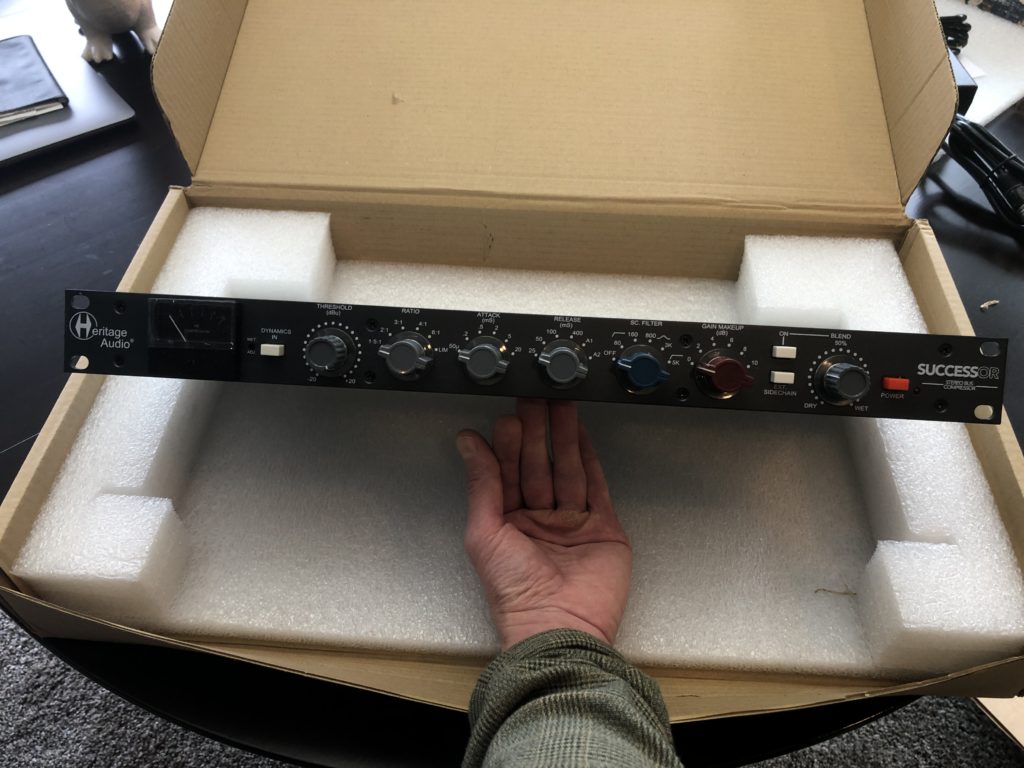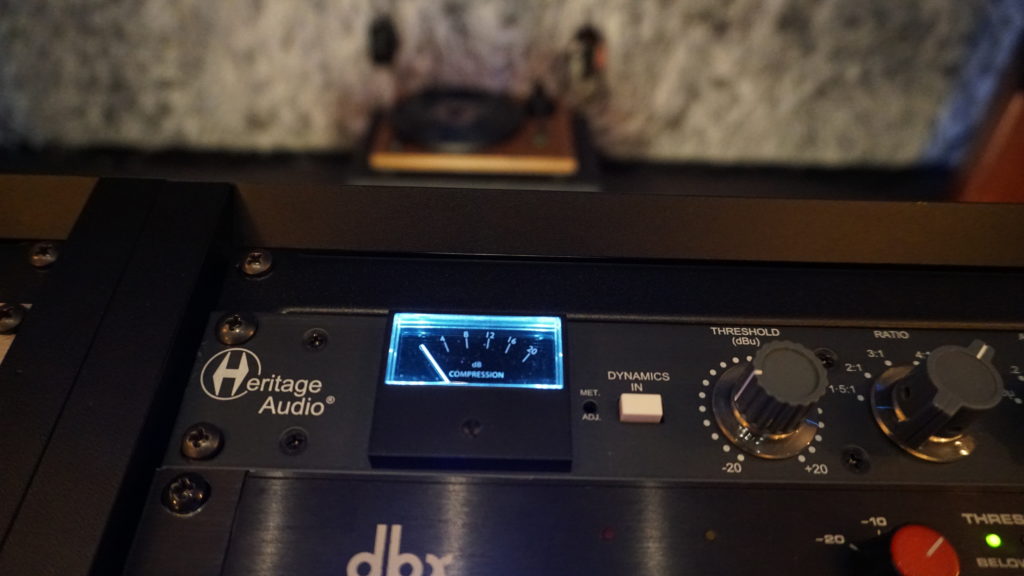According to the Heritage Audio website, the Successor is “a true stereo diode-bridge based bus compressor with advanced sidechain filtering and built-in parallel processing capabilities, sharing the class A 73 type output stage that Heritage Audio is famous for”. So, basically this is an all-analog, hardware compressor in the vein of those famous Neve bus compressors, but with some added bells and whistles. That is public knowledge, but here’s our experience with the Heritage Audio Successor.
We purchased this particular compressor to get yet another flavor option in our mastering chain. Having used the actual Neve hardware and a slew of the plugin emulations, I associated that sound with adjectives like “punchy”, “smacky”, “thick” and certainly “colorful”. No, these Neve units are NOT usually referred to as “sterile” or “transparent” by anyone who’s used them! Seeing that the Successor had a wet/dry blend knob and detented gain steps, it seemed like something that actually could be used in our mastering setup. Furthermore, the sidechain options looked incredibly unique and promising for specialized tasks like de-essing and/or de-harshing mixes. I was also really excited to try it on drum subgroups, bass, and just about everything else.

Luckily, buying our Successor in September of 2021 was easy and it arrived quickly to the doorstep. The unboxing was uneventful and the packaging was decent. The unit arrived a little dusty, but in otherwise perfect condition.
Pulling it out for the first time, it was much lighter and shallower than I imagined (considering this thing does have transformers on both the input and output stages). Installing it into the mastering desk went smoothly and everything plugged in snuggly.
As is only natural, the first thing I did after installing it was to turn it on and start fiddling with all the cool-looking buttons and knobs. The fully-stepped potentiometers have an easier, lighter touch than expected, but click around with an even feel. No vintage “cha-chunk” as you flip between settings, but it doesn’t necessarily feel cheap or sloppy in any way. The threshold and blend knobs have these finer, easier detents and feel optimal for their respective functions. The buttons all click in and out with a nice, solid action and I really like how the meter only lights up when the compressor is engaged- in fact, I can’t think of any other piece of hardware that feels as “official” to turn on!
Overall, it looks great. The colors, materials and layout all work really well. It’s a nice mix of Neve 1073 cues baked into an efficient, modern presentation…what’s not to like?

Well, after messing around with it for a bit, while reading the manual (which I should have done BEFORE buying), I realized that there is no way to hard-bypass this thing, without additional hardware. You can bypass the compressor section, as indicated by the “Dynamics IN” button, but no matter how you have the blend knob set, all audio still passes through the purposefully colorful input and output stages. This may not be an issue for most users, but it kind of took it out of the running as a mastering piece in our current setup. Seems a bit silly that Heritage audio did it this way and omitted it from the literature, but I guess they’re not aiming this product at mastering engineers. In fact, I emailed Heritage Audio about this and they responded saying that this is a “feature” that allows engineers to use the box’s color without any compression. Anyways, before throwing it back in the box and sending it back like some poor, unwanted pet; I figured let’s see what it sounds like…
The first thing I had a chance to try it on was drums for an album that came in for mixing. I was immediately surprised by the sheer extremity of sounds I was able to get, so quickly. This thing can attack and release in ways I have simply never heard before. Even when limiting with a fast attack and slow release, the snare still PUNCHES through, even on room mics. I could quickly tell that this compressor loves or…hates drums. In fact, the Successor so quickly ended up on the drum bus of every mix session, that it was hard to try it on anything else!

Here’s some notes I jotted down after the first day of using it on various drum duties:
”Love the way it reacts to cymbals- somehow adds excitement to transients, while warming up cymbal harshness. Not easy to do in VCA or digital land. Even with the fastest attack setting, the transient doesn’t sound rounded-off or squashed, it just…changes!”
”This is one pissed-off compressor! Does absolutely wild things to the audio.”
”Pumps and gasps like a champ; even to the point of absolute choppiness.”
“If this compressor was at a party it would be the one that ended some long-term relationships, punched some folks and then gets taken away in a police car.”
When we did finally manage to try the Successor on things other than drums, we had interesting results. In one instance, we attempted to strap it across the stereo mix of some background music, for some level control. Surprisingly, it wasn’t very helpful in leveling the mix in an average sort of way OR squishing the peaks down in any sort of useful way. It just wanted to either bug out or do nothing. We didn’t find any sort of great settings, but did settle on a 2:1 ratio with a 20mS attack, A2 release, 50 Hz side-chain filter, +4dB of makeup gain, blend at 80% and getting up to 4dB of gain reduction. It’s worth noting that the fixed 2dB gain steps made it impossible to level-match closely.
In another case, we used it on a vocal bus in a pop mix. This time it was hard to find a setting that sounded bad. On this particular vocal, it sounded pretty transparent until really hitting it hard. After some back and forth the settings were locked in at a 3:1 ratio 20mS attack, A1 release, 80 Hz side-chain, +2dB gain and getting up to about 3dB on the loudest bits. It wasn’t the only compressor in the chain, but it worked perfectly as that last bit of squeeze.
One could wrap this all up by saying this- we bought the Heritage Audio Successor for mastering, but love it on drums so much, it took over a year just to pull it off the drum bus long enough to finish this review!
Got a Question? Need A Quote? Want To Get Started?
© 2024 Fuzzywallz Recordings LLC